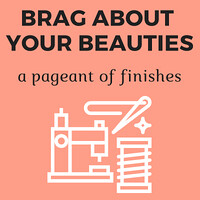Here in Massachusetts, we are in the home stretch before summer vacation, and I am in all-out quilting mode. My younger son is wrapping up his last days of middle school, and I will be gifting his team of teachers and therapists quilts. This has proved to be an effective motivation for getting projects bound and off my WIP list!
One project that is headed to its forever home is Windmill Weave, a design by Vickeidy Plybon of Sewspicious. The plan for this project has been in the works for a few years, so I’m especially pleased to be able to share it with you today!
The Fabric
The pattern is written to accommodate a single cut of yardage or multiple fat quarters. I knew the two-color version I wanted to sew merited something other than my usual solids, so I cut into my stash of Cirrus Solids by Cloud9 Fabrics.
I bought these fabrics years ago ... They’re lovely, yard-dyed solids, with a texture that gives them more personality than the Bella Solids I usually work with.
Because their weave is looser than other quilting cottons and because I was using white as a background, I hand-washed and machine-dried all of my yardage. In fact, I even used Retayne, a color fixative, on the Amazon yardage, to prevent bleeding.
To be honest, I'm not sure how readily Cirrus Solids are anymore, but I’ve enjoyed the projects I’ve made with them and was happy I had them on hand for this project. (See my Quilt Buzz Bingo project for another example of how I have quilted with Cirrus Solids.)
The Pattern
I am always on the lookout for a cleverly written pattern, and Windmill Weave did not disappoint! If you’re a partial-seam fraidy cat, you can construct the blocks without sewing a single partial seam. I, however, followed a supplementary blog post and sewed all nine of my blocks with partial seams.
Truly, they’re no big deal! My only words of warning for you are these: For the partial-seam approach with the square throw, I needed to sew 18 strip sets instead of 15. You could buy more yardage to accomplish this, but I chose to get creative with how I cut my yardage. Some of the necessary strips were cut width of fabric; others were cut along the length. In the end, I’m not sure exactly how much foreground fabric I used (I had already used a bit in this quilt). If you follow in my footsteps and sew this pattern with partial seams, be sure to do all the math up front to ensure you have enough fabric on hand.
The Quilting and Binding
I was at a loss for how to quilt this top. I knew I didn’t want to quilt it myself because I thought Windmill Weave’s strong geometry, with all those horizontal and vertical lines, would benefit from something softer and swirly-er than my straight-line quilting.
Taking a cue from the backing, I selected a panto with a circular pattern ...
I considered many different scenarios for the binding. (Doesn’t it seem as if the binding can make or break a project?!) I decided that the binding fabric should either be overstated (think: lime green!) or understated (think: white!). In the end, chose the understated option: I had a light gray in my stash that played off the light gray quilting thread.
Windmill Weave was an enjoyable make. I got to use my AccuQuilt Go to cut out all those skinny strips, streamlined the quilt-making process with strip sets as directed in the pattern, and busted through long-stashed yardage in the process. I might have another Windmill Weave in me. I think I would have fun with a second go by using multiple foreground fabrics. : )
Follow Me On ...
The pageant rules are simple:
- Post your finish in the linky tool. (No links to your own giveaway or linky, please!)
- Point your readers back here with a text link or use the button above.
- Visit and comment on other participants’ finishes.










